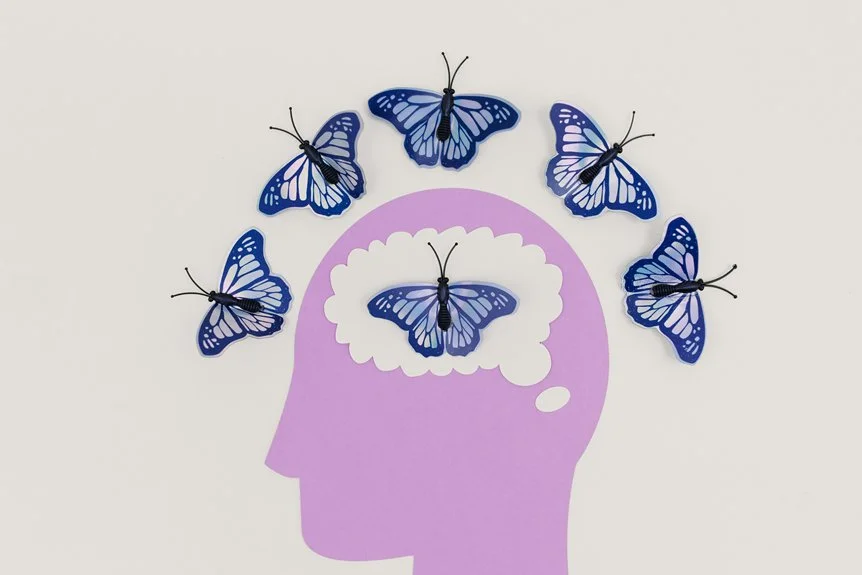
If you’ve got an ADHD brain, you know that feeling when your thoughts are bouncing around like a pinball machine while your body feels like it’s plugged into a live wire. I’ve been there more times than I’d like to admit, and through plenty of trial and error, I’ve discovered five surprisingly simple techniques that can hit the reset button on mental chaos in just minutes. These aren’t complicated strategies that require special equipment or hours of practice—they’re quick, practical tools that actually work when your brain needs immediate relief.
Key Takeaways
- Use the 4-7-8 breathing technique: inhale for 4 counts, hold for 7, exhale for 8 to activate calm.
- Engage in 30 seconds of physical movement like jumping jacks or wall push-ups to reset scattered thoughts.
- Practice 5-4-3-2-1 grounding by identifying specific things you can see, touch, hear, smell, and taste around you.
- Spend 10 minutes doing a brain dump by writing down all racing thoughts and worries without editing.
- Listen to brown noise, binaural beats, or instrumental music through headphones to create focused auditory environment.
Deep Breathing With the 4-7-8 Technique
When your ADHD brain feels like it’s running a million tabs at once, I’ve found that the 4-7-8 breathing technique works like a mental reset button that actually delivers on its promise.
Here’s how you master it: breathe in through your nose for 4 counts, hold that breath for 7 counts, then exhale completely through your mouth for 8 counts. I’ve noticed the magic happens during that 7-count hold, when your racing thoughts suddenly hit pause like someone pressed the brakes on a runaway train.
In my experience, doing this just three times creates an almost immediate shift from chaotic overwhelm to focused calm. The technique activates your parasympathetic nervous system, giving you back control when your mind feels like it’s spiraling.
Like tending to a garden that needs the right conditions, your mind requires proper care to maintain this newfound sense of calm and focus.
Physical Movement and Body Reset
Your ADHD brain craves movement like a plant craves sunlight, and I’ve discovered that getting your body moving is often the fastest way to shift from mental chaos to clarity.
In my experience, even thirty seconds of jumping jacks can completely reset my scattered thoughts, which honestly surprised me the first time I tried it during a particularly overwhelming workday.
I’ve noticed that specific movements work better than others – wall push-ups, desk stretches, or even aggressive paper shuffling can redirect that restless energy that’s bouncing around your skull.
The key is matching the movement intensity to your current energy level, so if you’re feeling wired, opt for something more vigorous like stair climbing rather than gentle stretching.
Creating a dedicated space for movement breaks can make these physical resets even more effective, whether it’s setting up resistance bands on a pegboard system or simply designating a corner of your room for quick body movement sessions.
Sensory Grounding With the 5-4-3-2-1 Method

Sometimes your ADHD brain needs an anchor when movement alone isn’t enough to pull you back from the mental whirlwind, and that’s where the 5-4-3-2-1 grounding technique becomes your secret weapon for instant sensory reset. I’ve noticed this method works because it forces your scattered attention onto concrete, present-moment details rather than letting it spiral into chaos.
Here’s how it works: identify 5 things you can see, 4 things you can touch, 3 things you can hear, 2 things you can smell, and 1 thing you can taste. In my experience, being specific helps tremendously—instead of “chair,” try “scratched wooden chair leg” or “soft blue throw pillow.” This technique literally rewires your focus from internal chaos to external stability, giving your overstimulated brain the sensory structure it desperately craves. This grounding method is particularly effective for quieting racing thoughts that make it impossible to concentrate on daily tasks.
Brain Dump and Thought Organization
Although grounding techniques work wonders for in-the-moment overwhelm, I’ve discovered that preventing that mental chaos in the first place often comes down to getting the swirling thoughts out of your head and onto paper through what I call a “brain dump.”
The ADHD mind tends to hold onto every random thought, worry, and task like a hoarder collecting mental clutter, and this constant internal noise makes it nearly impossible to focus on what actually matters right now.
I’ve found that dedicating ten minutes each morning to writing down everything bouncing around in my brain creates immediate mental space. You don’t need fancy tools—just grab whatever’s handy, whether it’s your Notes app, a napkin, or that journal you bought but never use, and let everything spill out without editing or organizing.
Once you’ve captured all those racing thoughts, you can break down larger tasks into smaller, more manageable steps, transforming that overwhelming mental jumble into actionable items that actually feel doable and clear.
White Noise and Auditory Focus Tools
While brain dumps help clear mental clutter, I’ve discovered that managing the constant auditory distractions around me requires a completely different approach—one that involves adding intentional sound rather than seeking silence. I’ve noticed that brown noise (deeper than white noise) through apps like Noisli or Brain.fm creates this cocoon of focus that drowns out office chatter, construction sounds, and my neighbor’s enthusiastic dog.
In my experience, noise-canceling headphones paired with binaural beats work like magic during deep work sessions, though I’ll admit I sometimes catch myself nodding along to the rhythm like it’s actual music. Rain sounds, ocean waves, or even café ambiance through MyNoise.net transforms my chaotic environment into a productivity powerhouse, giving you complete auditory control. For maximum effectiveness, I stick with instrumental music to avoid the distraction of lyrics pulling my ADHD brain in different directions.
Conclusion
I’ve noticed that when my ADHD brain feels like it’s running a marathon while juggling flaming torches, these five techniques work like magic to hit the reset button. You don’t need to master all of them at once—in my experience, even picking one or two that resonate with you can make those overwhelming moments feel manageable again, and honestly, that’s a pretty solid win in my book.





Pingback: 6 Letting Go Practices for True Peace